There are over 60 different types of spiders in Virginia. However, you’ll only encounter a handful of these spiders in the state because most species are rare.
This article will cover all the important spiders in Virginia. By the end, you’ll know which species are native to the state and how to identify them. You’ll also learn some pretty cool facts about each one.
If you’re unfamiliar with spiders, cool probably isn’t the word you use when describing them. You might think creepy, dangerous, or intrusive. This is understandable—some species can be hard to deal with.
But not all spiders litter your house with annoying cobwebs, inflict painful bites, or look terrible. Many species don’t spin cobwebs, most rarely bite, and several spiders look stunning.
Of the 60+ spiders in Virginia, only 2-3 species are dangerous. Fortunately, one is hard to come by, and none sting unprovoked.
Having spiders around your home or garden has advantages. These fascinating arachnids feed almost exclusively on other arthropods, especially insects. As a result, they can act as natural pest control agents.
Spiders are highly diverse, and North America alone hosts over 3,600 species. Read on to learn which ones call Virginia home.
Table of Contents
Spiders in Virginia
1. Southern Black Widow

- Experience Level: Advanced
- Family: Theridiidae
- Scientific Name: Latrodectus mactans
- Other Names: Black Widow, Widow Spider
- Adult Size: Up to 0.5 inches
- Lifespan: 1 to 3 years
- Average Price Range: N/A
Even if you don’t know much about spiders, you’ve probably heard of the infamous black widow, made popular by Hollywood and pop culture references. This spider is one of the deadliest in the world, and its bites often require medical attention.
Virginia plays host to two black widow species: the northern black widow and the southern black widow. Both species look virtually identical, but you can tell them apart if you’re attentive.
Like all black widows, the southern black widow is often pitch black with a polished, shiny abdomen. You can identify this spider by the red hourglass marking on its abdomen’s underside.
Unlike its northern sibling, the hourglass marking on the southern black widow’s underside is complete and unbroken.
Despite its reputation as a deadly spider, this species is not aggressive. Bites are rare and are usually the last resort when the spider feels threatened. The neurotoxic venom of this species can cause death, but this is a rare outcome.
If a southern black widow bites you, expect to suffer symptoms like nausea, difficulty in breathing, and fever. It often causes latrodectism, a condition marked by vomiting, muscle stiffness, and sweating.
Extreme outcomes are more common among children, the elderly, and people with weakened immune systems.
Since it’s not always clear what the outcome of a bite will be, always seek medical attention if you suspect a southern black widow has bitten you.
Black widows are called so because of their mating habits. Females are larger than males and typically consume their male partners shortly after mating, making them widows.
2. Northern Black Widow
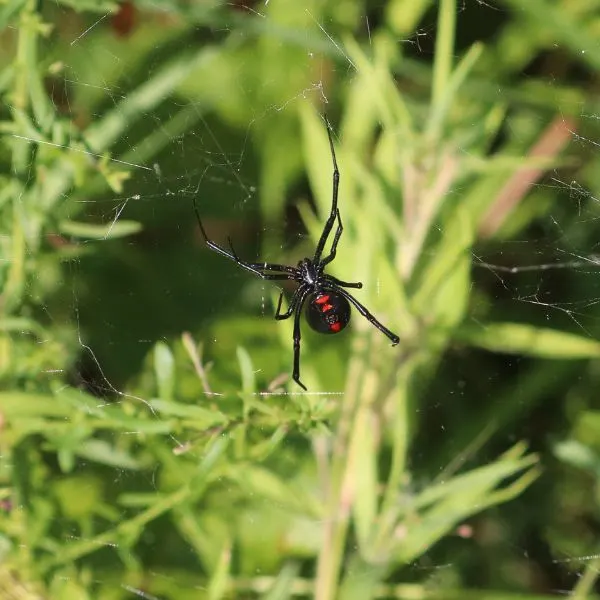
- Experience Level: Advanced
- Family: Theridiidae
- Scientific Name: Latrodectus variolus
- Other Names: Black Widow, Widow Spider
- Adult Size: Up to 0.5 inches
- Lifespan: 1 to 3 years
- Average Price Range: N/A
The northern black widow is the sibling of the southern black widow. It is equally venomous and often ranges close to southern black widow territory. It has a glossy black body and a large bulbous abdomen.
If you examine this spider closely, you can differentiate it from the southern black widow. The northern black widow also has a red hourglass marking on the underside of its abdomen. But, unlike its sibling, this hourglass marking is broken in the middle.
The hourglass marking on the northern black widow resembles two triangles. Besides this difference, both species are difficult to tell apart.
Since the northern black widow is just deadly as its southern sibling, the distinction between both species isn’t important for laypersons. If you suspect a black widow has bitten you, seek medical attention immediately, regardless of the species.
Male northern black widows have much shorter lifespans than females. As soon as they reach maturity, they live their lives with the end goal of mating with females. Females consume them after mating.
3. Brown Widow
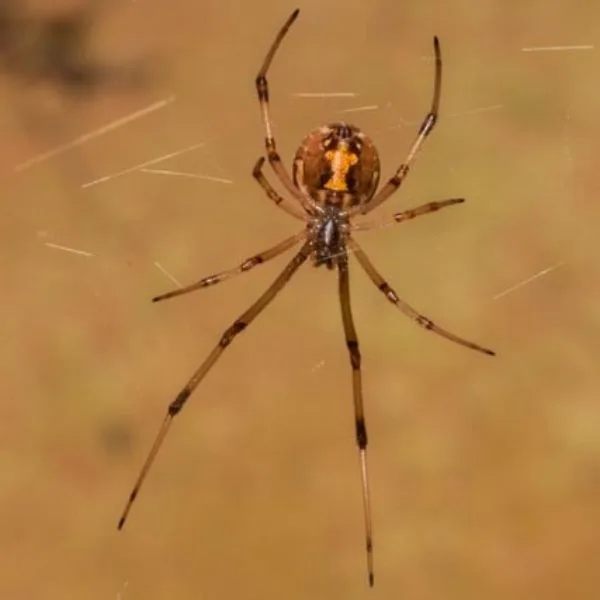
- Experience Level: Beginner
- Family: Theridiidae
- Scientific Name: Latrodectus geometricus
- Other Names: Widow Spider, Button Spider
- Adult Size: 2 to 3 inches
- Lifespan: 1 to 3 years
- Average Price Range: N/A
The brown widow is the far less popular relative of black widows. Its bite is not medically significant, but it can be pretty painful. Fortunately, the species is unaggressive, so bites are unusual.
Technically, the brown widow is just as venomous as black widows. What makes its bite less harmless is that it injects a smaller dose when it bites humans. It almost never causes latrodectism.
This arachnid has a black abdomen, but its abdomen is primarily brown and tan with some black markings. Like black widows, this species has a red hourglass shape on its belly.
Although you’ll find brown widow spiders in Virginia and many other US states, they aren’t native to the United States. They likely originated in Africa or South America. In the US, they were initially confined to the Florida peninsula before becoming more widespread in the 2000s.
Brown widows often stay in secluded areas in homes, such as garages or rarely cleaned places. Outdoors, you may find them in mailboxes, car undercarriages, or on railings.
They spin tangled webs, which they use to catch prey. You’ll often find egg sacs suspended in their webs. Unlike black widows, the egg sacs of brown widows are spiky instead of smooth.
4. False Black Widow

- Experience Level: Beginner
- Family: Theridiidae
- Scientific Name: Steatoda grossa
- Other Names: False Widow, Brown House Spider, Dark Comb-Footed Spider, Cupboard Spider
- Adult Size: 0.25 to 0.4 inches
- Lifespan: 1 to 6 years
- Average Price Range: N/A
The false black widow is a distant relative of black widows. People often mistake it for true black widows, but they are easy to tell apart. Unlike true widows, the false widow lacks a red hourglass marking on its abdomen.
The false widow has a large bulbous abdomen shaped like those of true black widows. Its body is usually brown, although the exact shade varies. In the dark variant, you’ll notice the body is more purple or brown than black if you hold the spider closely.
The black widow is a predatory arachnid, feeding on small insects it traps in its webs. It often injects its victims with venom to immobilize them before digesting them.
While you might not enjoy seeing false black widows around, they are beneficial. These arachnids specifically prey on black widows and can help you control their populations at home.
While the false widow is a venomous spider, its venom is significantly less toxic than true black widows. Bites are uncommon. But if a false black widow bites you, it won’t hurt more than a bee sting.
5. Brown Recluse
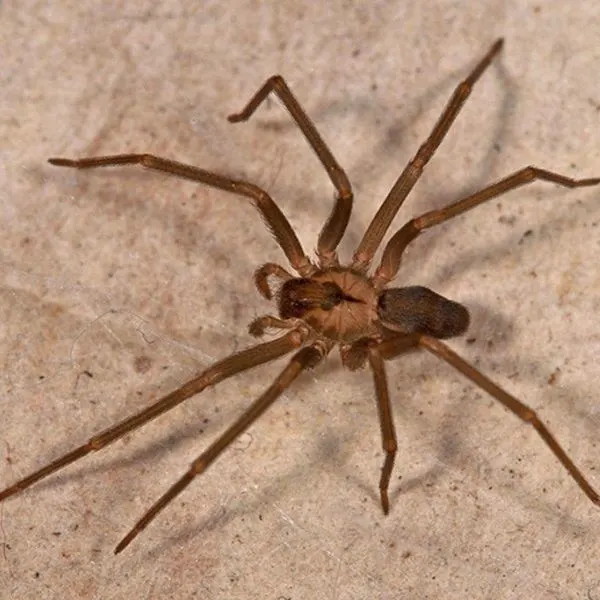
- Experience Level: Advanced
- Family: Sicariidae
- Scientific Name: Loxosceles reclusa
- Other Names: Violin Spider, Brown Fiddler, Fiddleback
- Adult Size: 0.24 to 0.8 inches
- Lifespan: 2 to 4 years
- Average Price Range: N/A
Besides black widows, brown recluses are the only other spiders in Virginia that inflict medically significant bites.
Their venom is completely different from that of black widows. While it doesn’t directly cause death, it can do serious damage.
The venom of this species is cytotoxic, meaning it kills cells and tissues. If a brown recluse bites you, you might develop a wound at the bite site. The injury sometimes expands into an ulcer that’s difficult to manage unless you treat it immediately.
This arachnid sometimes inflicts what is known as “dry bites” on humans. Dry bites are warning bites that don’t contain venom, so they are safe. Sadly, it’s impossible to tell what kind of bite it’ll inflict, so it’s best you avoid the spider.
The venom of this spider is effective against prey. Unlike most spiders in Virginia, it doesn’t use webs to snare prey. Instead, it hunts them down and injects them with its cytotoxic venom to make digestion easier.
You can identify the brown recluse by the violin-shaped marking on its carapace. The body is brown or tan. While the abdomen is lighter than the carapace, it is uniformly colored and covered in fine hairs.
Most spiders in Virginia have eight eyes. However, the brown recluse has only six. Its eyes are in three separate pairs. The legs lack spines and are slightly darker than the body.
Brown recluses are, as their names suggest, recluses. It’s hard to come across these spiders in Virginia because they love to stay hidden and have insignificant populations. Besides their tendency to avoid open spaces, these spiders are nocturnal, making encounters rare.
It’s hard to keep brown recluses as pets because of the nature of their venom. While they rarely bite unless provoked, mishandling can result in unpleasant scars that remain long after the spiders have died.
6. Long-legged Sac Spider

- Experience Level: Beginner
- Family: Eutichuridae
- Scientific Name: Cheiracanthium mildei
- Other Names: Northern Yellow Sac Spider
- Adult Size: Up to 0.4 inches
- Lifespan: 1 year
- Average Price Range: N/A
Long-legged sac spiders aren’t deadly, but they have a reputation for inflicting painful bites.
Also called yellow sac spiders, these arachnids have mostly pale yellowish-brown bodies. Some individuals appear yellowish-green.
The cephalothorax is usually darker than the abdomen and may have several tiny black markings. On the abdomen, you’ll notice a dark central stripe that runs from the waist but tapers off in the middle of the abdomen.
This species is a hunter, so it goes after prey instead of waiting for them to come to it. It doesn’t spin conventional webs, but it spins a sac-like web for shelter. This sac-like web is what earned it its name.
You can find long-legged sac spiders outdoors and indoors. Indoors, they often restrict themselves to corners and uninhabited spaces. They typically take shelter under leaves, floorboards, rocks, and forest litter outdoors.
These spiders are nocturnal, so you’re unlikely to sight them in the daytime. They fall under the category of spiders most people don’t like to have around.
7. Yellow Garden Spider
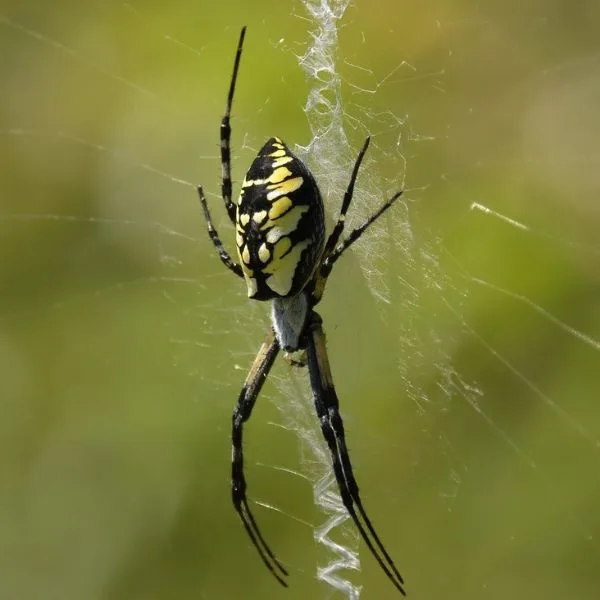
- Experience Level: Beginner
- Family: Araneidae
- Scientific Name: Argiope aurantia
- Other Names: Black And Yellow Argiope, Black and Yellow Garden Spider, Zipper Spider, Zigzag Spider, Corn Spider, McKinley Spider, Golden Garden Spider, Steeler Spider
- Adult Size: 0.75-1.1 inches
- Lifespan: 1 year
- Average Price Range: N/A
The yellow garden spider goes by many names, all describing the pattern of this arachnid’s body. It has yellow and black banded legs and a black cephalothorax covered dorsally in whitish hair. The abdomen is a mix of black and yellow.
The exact pattern on its abdomen varies between individuals. However, it often consists of a central black stripe with four pairs of round, yellow markings. The rest of the abdomen is mostly yellow, with thin black spheres.
You’ll often find yellow garden spiders in gardens and other areas rich in vegetation. They spin large webs, which they use to catch prey. Sadly, many people often remove these spiders from their gardens.
Because of their diet, the presence of yellow garden spiders in your garden helps control annoying insect pests. This is beneficial, not just to you but to the ecosystem as well.
Yellow garden spiders are, like other spiders, venomous. But their venom is harmless to human beings, with even severe bites hurting less than or about the same as a bee sting.
8. Tiger Wolf Spider

- Experience Level: Beginner to Intermediate
- Family: Lycosidae
- Scientific Name:
- Other Names: Speckled Wolf Spider, Wolf Spider
- Adult Size: 0.5 to 0.8 inches
- Lifespan: 1 year
- Average Price Range: N/A
The tiger wolf spider is a hairy wolf spider. Unlike other spiders in Virginia, it does not spin webs and waits for prey to wander into them. It is a hunter, so it searches for prey on the ground and bites its victims into submission.
This species is one of the largest spiders in Virginia. Although it’s hard to tell apart from similar wolf spider species, the body has mottled brown, tan, and black colorations. In addition, its body is covered in brown hairs, and the legs bear spines.
The tiger wolf spider can seem intimidating if you’re unfamiliar with it, but it is harmless. It might bite when threatened without an escape route, but the venom only causes mild to moderate pain.
You can find this arachnid in areas with ample vegetation. It favors forests, grasslands, and bushes, where it often hides under rocks and debris. You may also encounter it indoors, especially in colder months.
Although this spider doesn’t spin typical webs, it spins silk sacs to protect its young. Females demonstrate superb maternal instincts. They often carry their eggs around until they hatch.
After hatching, young tiger wolf spiders ride around on their mother’s back. They disperse after a while to start their own lives.
9. Common House Spider
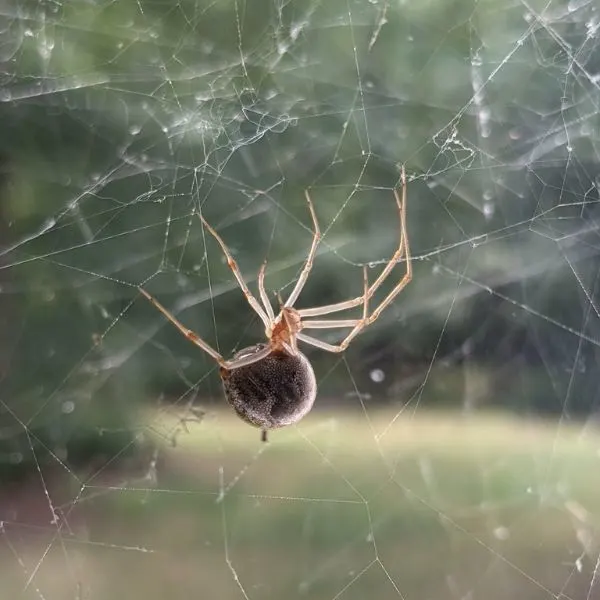
- Experience Level: Beginner
- Family: Theridiidae
- Scientific Name: Parasteatoda tepidariorum
- Other Names: American House Spider
- Adult Size: 0.15 to 0.24 inches
- Lifespan: 1 year
- Average Price Range: N/A
The common house spider is cosmopolitan, so you’ll find it in various kinds of places, from gardens and forests to homes. At home, common house spiders often stay in attics. But you’ll find them anywhere from cellars and barns to windowsills.
The name of this species comes from the fact that it is one of the most encountered spiders in North America. Despite its spread, it often avoids human interaction. It builds its webs in corners and dimly-lit areas, rarely straying into open spaces.
This arachnid spins tangled webs to catch prey. It has a neurotoxic venom that it uses to immobilize its victims. While this venom is similar to that of black widows, it is significantly less toxic. It is harmless to humans.
You’ll usually find the webs of common house spiders near each other in places where prey is abundant. However, these spiders are aggressive towards neighboring spiders when prey is scarce.
Common house spiders generally have small bodies, but their abdomens are several times bigger than their cephalothorax.
Their cephalothorax is brown, while their bellies have black and tan or brown patches. Their legs are translucent with brown joints.
10. Southern House Spider
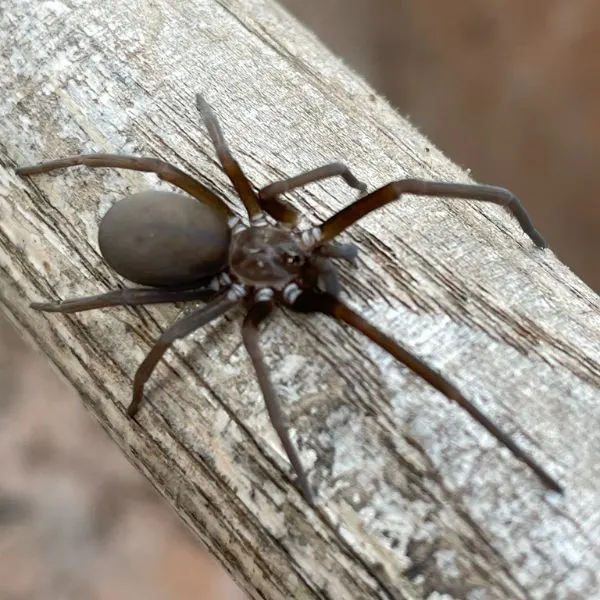
- Experience Level: Beginner
- Family: Filistatidae
- Scientific Name: Kukulcania hibernalis
- Other Names: Southern House Spider
- Adult Size: 0.35 to 0.75 inches
- Lifespan: 1 to 7 years
- Average Price Range: N/A
Southern house spiders are also called crevice spiders.
This name comes from their preference for living in crevices and small cracks or spaces. At home, you’ll usually find them in wall crevices or the tiny spaces between infrequently moved furniture.
These spiders spin large, sticky webs that start at the entrance of their crevices. They hide in their crevices during the day, but they spend nighttime on their webs and consume prey stuck on them. Their webs are flat and horizontal.
Although you’ll sometimes find the webs of this species on tree barks in forests, the webs are more common in man-made structures. These arachnids often litter their webs with debris and the body parts of consumed insects.
Female southern house spiders have significantly larger abdomens than males. They are dark gray and have mottled abdomens. When full or pregnant, their abdomens often distend much lower than other spiders in Virginia.
Male southern house spiders are brown and have relatively slender abdomens compared to females. People sometimes mix up these arachnids with brown recluses.
Like recluses, males have lined patterns extending from behind their eyes. The pattern converges in the middle of the carapace, similar to the violin on brown recluses.
You can tell male southern house spiders apart if you look closely. Unlike recluses, they have eight eyes instead of six.
The pattern on their carapace is narrower and stops midway down the carapace. In brown recluses, the violin pattern extends to the end of the carapace.
Southern house spiders are safe to be around. While they inflict venomous bites, their venom is harmless to humans. However, if you’re allergic, you might experience some pain and swelling.
Female southern house spiders live longer than males.
11. American Nursery Web Spider
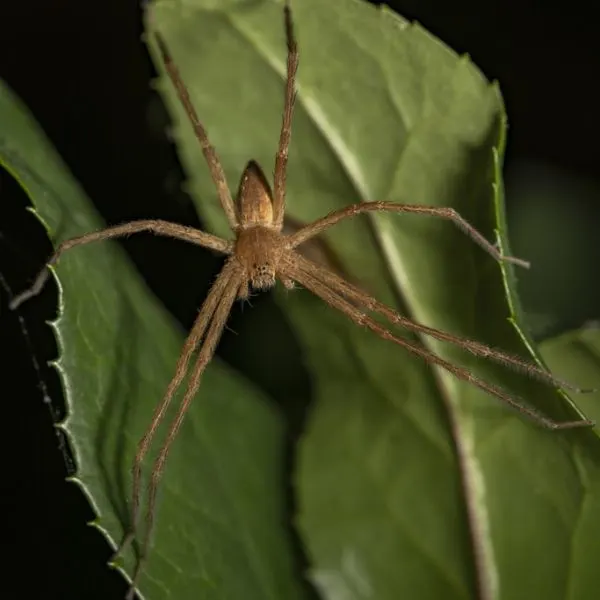
- Experience Level: Beginner
- Family: Pisauridae
- Scientific Name: Pisaurina mira
- Other Names: Nursery Web Spider
- Adult Size: 0.35 to 0.7 inches
- Lifespan: 1 to 2 years
- Average Price Range: N/A
American nursery web spiders are hairy spiders with mottled bodies.
Their abdomens are longer than wide, while their carapaces are shorter. They often have a dark stripe running through the middle of their backs.
American nursery web spiders come in a variety of colors. Most are earth brown.
However, some variants have teal or blue bodies. Blue nursery spiders have a fascinating translucent appearance, and the spines on their legs are more conspicuous.
Many people mistake brown nursery spiders for wolf spiders, but both spiders belong to different families. American nursery web spiders also have a different eye arrangement from wolf spiders.
While wolf spiders are more common on the ground, nursery web spiders usually live above ground. You’ll often find American nursery web spiders in places with vegetation, such as shrubs and grasslands.
Instead of using webs to trap prey, these arachnids hunt them down. They generally sting victims to death before consuming them.
Female American nursery web spiders are believed to be cannibalistic towards males after mating. While there are arguments supporting and disproving this belief, males show caution when mating with females.
Just before mating, males bind the first two pairs of their partners’ legs. The reason for this behavior is unclear.
However, researchers believe the restrictive silk binder is laced with pheromones or simply restrictive to prevent females from consuming males immediately after mating.
Female nursery web spiders show considerable maternal care. They spin sacs for their eggs and carry them in their jaws until the eggs hatch. After hatching, females guard their young until their first molting.
Like most spiders in Virginia, American nursery web spiders are safe to keep. They rarely bite, and their venom is harmless. But you might experience temporary pain, redness, and swelling if you’re allergic.
12. Giant Lichen Orbweaver
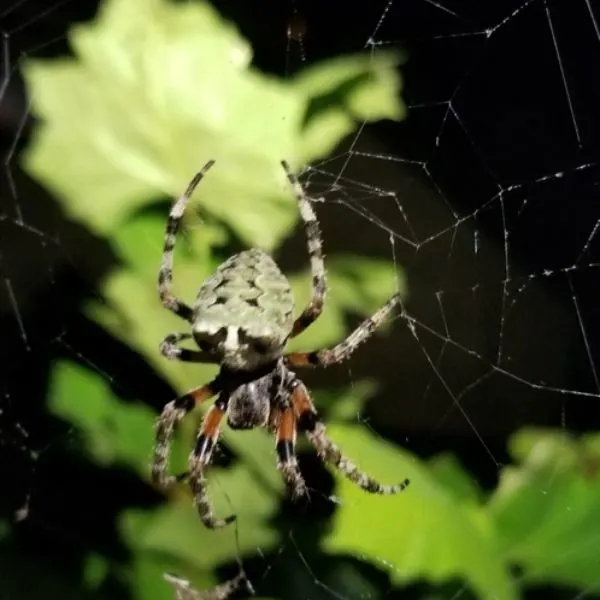
- Experience Level: Beginner to Intermediate
- Family: Araneidae
- Scientific Name: Araneus bicentenarius
- Other Names: Orb-weaver
- Adult Size: Up to 1 inch
- Lifespan: 1 year
- Average Price Range: N/A
Giant lichen orb-weavers are among the heaviest spiders in Virginia.
They have massive round abdomens several times the size of their cephalothorax. A distinctive feature of these spiders is the lump or protrusion on the back of their abdomens.
The abdomen of the giant lichen orb-weaver has a pattern resembling the lichens found on rocks. It is mostly green with brown markings and black zigzag patterns in the middle. The cephalothorax is dark with whitish hairs on the carapace.
Giant lichen orb-weavers have black and green banded legs with orange bases. The legs are hairy, and the green parts often appear blotched because of the hairs. You may find variants with different colors.
You’ll usually find these spiders in grasslands, where they spin spiral webs to trap prey. Their webs can be as wide as 8 feet, among the largest orb-weavers make.
They avoid the center of the webs and prefer to stay on the fringes, presumably to hide from prey and predators.
These arachnids are carnivorous and feed primarily on arthropods. While they are ruthless with prey, giant lichen orb-weavers are unaggressive towards humans and potential predators.
These nocturnal spiders rarely bite. If one bites you, you might experience pain and develop some swelling in the bite area. But these symptoms go away on their own.
13. Orchard Orbweaver
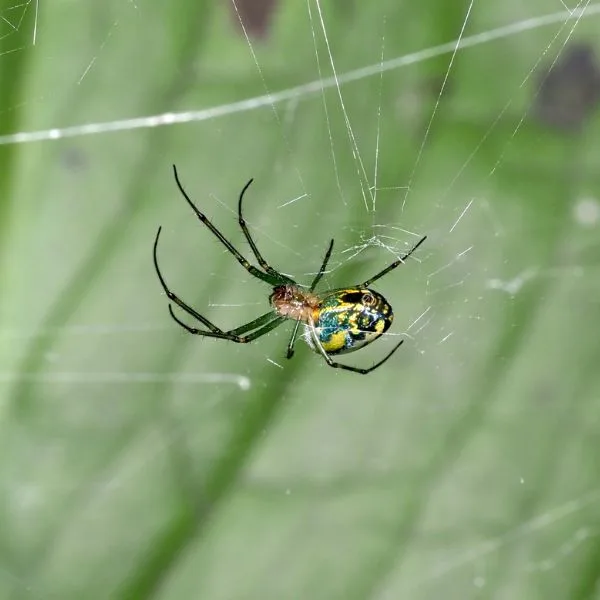
- Experience Level: Beginner
- Family: Tatragnathidae
- Scientific Name: Leucauge venusta
- Other Names: Long-jawed Orb-weaver
- Adult Size: 0.14 to 0.3 inches
- Lifespan: 1 year
- Average Price Range: N/A
The orchard orb-weaver is one of the more beautiful spiders in Virginia. It has a small cephalothorax and a massive abdomen. The abdomen is slanted upwards and has white, green, yellow, and black markings.
The back of the abdomen is mostly white, with a narrow black stripe running down the middle. This stripe branches out on both sides like the veins in a leaf.
On the sides, the yellow and green markings are more prominent. This arachnid has orange to red triangular markings on its belly, causing some people to mistake it for a widow spider.
The cephalothorax of this spider is pale with dark stripes, while the legs are half green and half black. These legs also have short hairs and spines.
Orchard orb-weavers are often found in orchards, hence the name. But these fine critters also hang out in other places with lots of vegetation. When temperatures fall, some seek shelter in buildings.
These arachnids are web-spinners that set traps for prey instead of hunting them. They inject victims with venom before consuming them, but this venom is harmless to humans.
14. Triangulate Combfoot

- Experience Level: Beginner
- Family: Theridiidae
- Scientific Name: Steatoda triangulosa
- Other Names: Triangulate Cobweb Spider, Triangulate Bug Spider
- Adult Size: Up to 0.25 inches
- Lifespan: 1 to 3 years
- Average Price Range: N/A
The triangulate comb-foot belongs to the same family as black widows.
But it’s pretty harmless compared to them. While it injects venom when threatened, you won’t experience any symptoms beyond temporary pain and swelling.
This arachnid gets its name from the pairs of white to yellow zig-zag markings running down the back of its abdomen. These pairs converge at several points to form a triangular pattern.
Like most members of its family, this species has a massive, bulbous abdomen. Its body is mostly brown, and its legs are covered in tiny hairs.
The triangulate comb-foot feeds primarily on small insects. To trap them, it spins tangled cobwebs that are hard for victims to escape from.
Any insect caught in its webs triggers vibratory signals along the strands while trying to break free, alerting the spider.
At home, you’ll usually find the webs of this spider in the dark corners of walls or ceilings.
15. Eastern Parson Spider
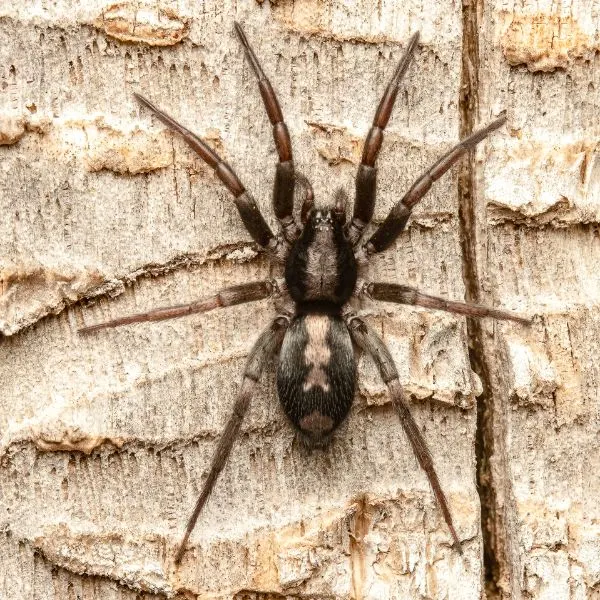
- Experience Level: Beginner to Intermediate
- Family: Gnaphosidae
- Scientific Name: Herpyllus ecclesiasticus
- Other Names: Stealthy Ground Spider, Ground Spider
- Adult Size: 0.3 to 0.8 inches
- Lifespan: 1 to 2 years
- Average Price Range: N/A
The eastern parson spider is a black to dark gray arachnid covered in thick, velvety hair. It is often mistaken for the similar-looking mouse spider, but the parson spider has a whitish marking on its abdomen that helps differentiate it.
The marking on the back of this spider resembles the neckband catholic clergymen wore in the past. Clergymen are also called parsons, which is how the spider got its name.
Another identifying feature is the two pikes at the end of this arachnid’s abdomen. This nocturnal hunter also runs in a characteristic zigzag pattern and has incredible speed, a skill that is handy when hunting down prey and evading predators.
You’ll often find eastern parson spiders in groups. They mate virtually year-round and produce thousands of eggs. While these spiders are rarely offensive towards people, they will bite without hesitation when threatened.
The venom of this spider isn’t medically significant, but its bite can be pretty painful.
Also, you might develop swelling or mild skin reactions if you’re allergic to spider venom. But these go away on their own.
16. Broad-faced Sac Spider
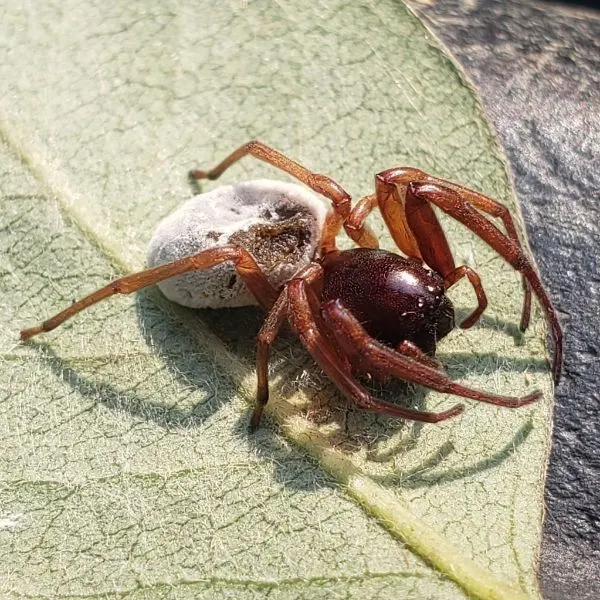
- Experience Level: Beginner
- Family: Trachelidae
- Scientific Name: Trachelas tranquillus
- Other Names: Bullheaded Sac Spider, Sac Spider
- Adult Size: 0.19 to 0.39 inches
- Lifespan: 1 year
- Average Price Range: N/A
Like all sac spiders in Virginia, the broad-faced sac spider doesn’t spin conventional webs to trap prey.
It spins a sac-like shelter for itself to rest in during the day. At night, it leaves its sac and hunts down other arthropods to devour.
This spider is pretty outdoorsy. While it sometimes strays into homes during cold seasons to avoid freezing to death, it rarely establishes sizable populations indoors. Forests and bushes are the best places to look for this species.
The broad-faced sac spider has a dark to reddish-brown cephalothorax, while the abdomen is tan. The body is devoid of any distinct pattern, and its front pair of legs are longer than the rest.
This species is sometimes mistaken for woodlouse spiders, but it has a longer jaw than woodlouse spiders. Its eyes are also more widely-spaced than those of woodlouse spiders.
Broad-faced sac spiders aren’t aggressive. They only bite when threatened, but their bites can hurt. Thankfully, their venom is not medically significant, so symptoms go away on their own.
17. Long-bodied Cellar Spider
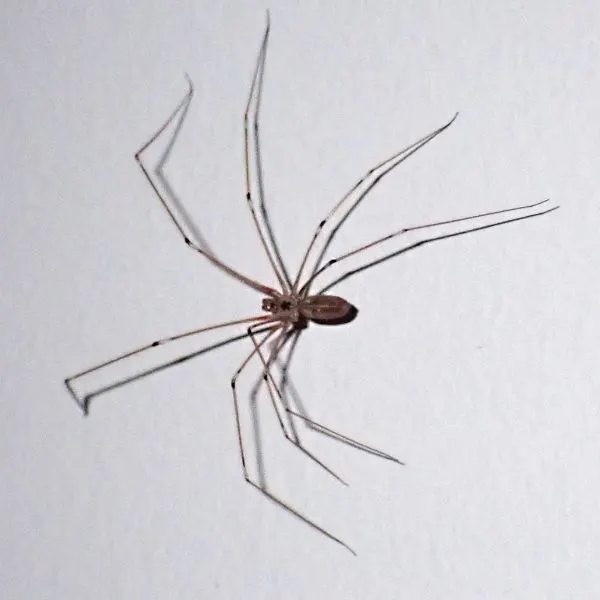
- Experience Level: Beginner
- Family: Pholcidae
- Scientific Name: Pholcus phalangioides
- Other Names: Daddy Longlegs, Cellar Spider, Granddaddy Longlegs, Vibrating Spider, Daddy Longlegger, Carpenter Spider, House Spider, Skull Spider
- Adult Size: Up to 0.4 inches
- Lifespan: 2 years
- Average Price Range: N/A
The long-bodied cellar spider is one of the most common spiders in Virginia. It’s known in the US and many parts of the world as daddy longlegs. While it’s not the first arachnid to bear this name, the name is perfectly reasonable.
Long-bodied cellar spiders are small critters with large abdomens, but they have incredibly long legs that make them appear larger than they truly are. These legs can be up to six times their body length.
These tan to brown spiders often inhabit the dark, infrequently cleaned corners of cellars at home. But it’s common to see them in other places like window sills and ceiling corners anywhere in the house.
They spin webs to catch prey and for shelter. You’ll usually see them hanging upside-down in these webs, waiting for prey.
Since their eyesights are poor, they rely on vibratory signals triggered by struggling prey to locate insects caught in their webs.
Although the webs of cellar spiders can be unsightly, these spiders help curb the population of other less pleasant bugs at home. Their victims include venomous spiders like the brown recluse.
When threatened, the long-bodied cellar spider often flees or bounces vigorously in its web. This action distorts the web, making it too blurry for predators to determine the spider’s location on the web.
This spider is harmless to humans. Although it has a mild venom, its venom is either too weak to cause any symptoms, or the spider’s fangs don’t penetrate people deeply enough.
The jury is still out on which it is, but you’re safe playing with this spider.
18. Bowl and Doily Spider
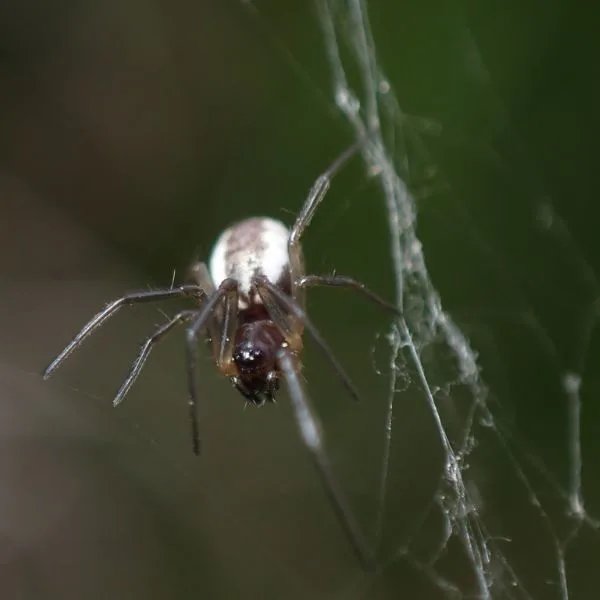
- Experience Level: Beginner
- Family: Linyphiidae
- Scientific Name: Frontinella pyramitela
- Other Names: Sheet-weavers
- Adult Size: Up to 0.15 inches
- Lifespan: 1 year
- Average Price Range: N/A
The bowl and doily spider is named after the complex shape of its webs. It spins a horizontal, flat, or doily-shaped web under a bowl-shaped one. Like other sheet-weavers, it uses its webs to catch prey.
The web of this spider is not sticky, but the structure works. You’ll often see this arachnid hanging out on the doily, waiting for prey to enter its bowl.
While still outside, it injects any insect that enters the bowl with venom before rushing in to finish the job.
The venom of this tiny arachnid is effective at immobilizing prey, but it is harmless to humans. You might experience pain and itchiness if you have allergies, but even this outcome is rare.
You can identify the bowl and doily spider by the whitish comma-shaped vertical lines on the sides of its large, dark brown abdomen. The vertical lines turn yellowish as they curve towards the abdomen’s underside.
The carapace of this spider is shiny, dark brown, and hairless. The legs are more or less the same color, but they are covered in tiny hairs and lighter near the body.
19. Furrow Orbweaver

- Experience Level: Beginner
- Family: Araneidae
- Scientific Name: Larinioides cornutus
- Other Names: Furrow Spider, Foliate Spider, Furrow Orb Spider
- Adult Size: 0.4 to 0.5 inches
- Lifespan: 1 Year
- Average Price Range: N/A
The furrow orb-weaver has a large, round abdomen with wavy lines running down the middle. These lines resemble the furrows left behind after a plow has tilled the soil, hence its name.
The abdomen of this spider comes in various colors, from brown and gray to reddish. In most variants, the middle of the abdomen is a broad, dark brown stripe. The wavy lines border this broad, dark stripe on both sides.
The carapace is reddish and covered in white hairs, while the legs are banded and spiny.
You’ll usually find these orb-weavers in moist places with plenty of vegetation. Most sightings are outdoors, but you might encounter these spiders in buildings when seasonal temperatures fall.
Furrow orb-weavers spin wheel-shaped webs with widely spaced circles, which they use to trap prey. They prey on various insects and inject them with venom before devouring them.
The venom of this spider is harmless to humans, so you have nothing to fear when you encounter it. The most adverse reactions from bites typically include mild pain, swelling, or itching.
20. Banded Garden Spider
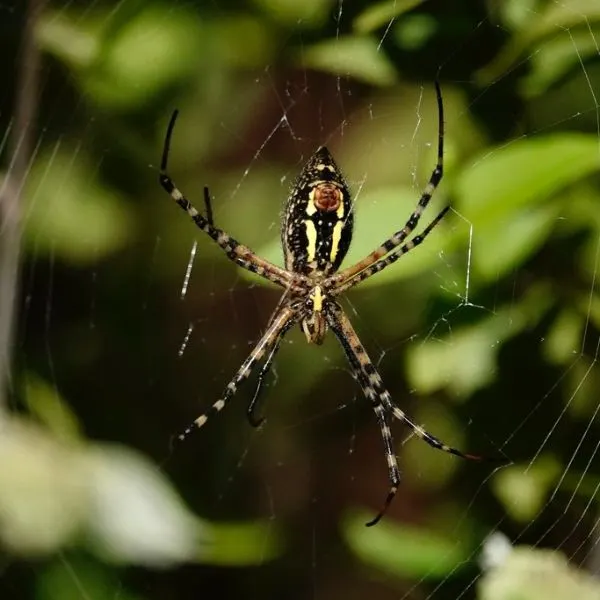
- Experience Level: Beginner
- Family: Araneidae
- Scientific Name: Argiope trifasciata
- Other Names: Orb-weaver Spider, Yellow Garden Spider
- Adult Size: 0.59 to 0.98 inches
- Lifespan: 1 year
- Average Price Range: N/A
The banded garden spider has long, spiny legs. These legs are brown with black bands in the lower half. Unlike most orb-weaving spiders in Virginia, the abdomen isn’t much wider than the carapace.
This arachnid’s abdomen varies in color, from reddish-brown to dark brown. The abdomen also has several white and yellow bands running across it from side to side, the feature it’s named after.
This orb-weaver doesn’t hunt prey. Instead, it builds large webs and subsists on insects and bugs its webs catch. You’ll usually find it upside-down in the center of its web, waiting for prey. It uses vibratory signals to locate victims caught in its nest.
You’ll usually find these spiders in gardens, forests, shrublands, and grasslands. They typically spin their webs between leaves of tall grasses and plants. During mating seasons, males share the same webs with females.
Like other orb-weaving spiders in Virginia, the banded garden spider is not aggressive. It rarely bites, except when threatened. Fortunately, its venom is harmless to humans.
21. Marbled Orbweaver
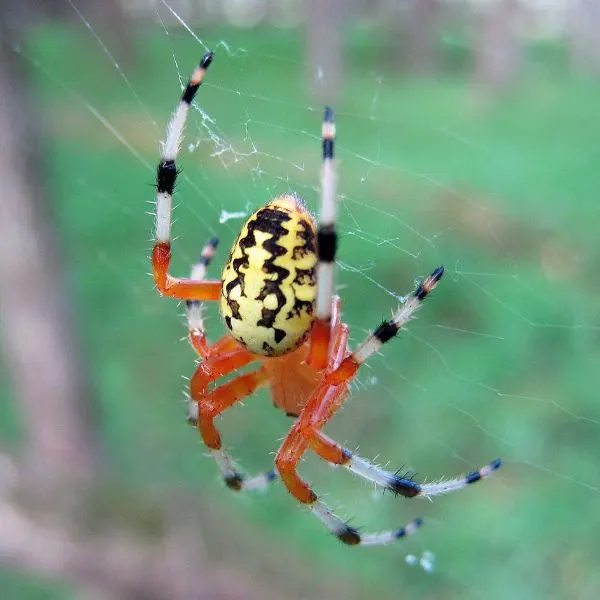
- Experience Level: Beginner
- Family: Araneidae
- Scientific Name: Araneus marmoreus
- Other Names: Pumpkin Spider
- Adult Size: 0.2 to 0.7 inches
- Lifespan: Less than 1 year
- Average Price Range: N/A
The marbled orb-weaver is a beautiful orange spider with cream, whitish, black, and yellow markings on its large, pumpkin-shaped abdomen. These markings look like the intricate patterns seen on marbles.
Its cephalothorax is pale orange, while its spiny legs are orange in the upper part and translucent white with black bands in the lower parts.
This spider spins orb-shaped webs in shrublands, reeds, and other places abundant with vegetation. It uses its webs as shelter and as traps to catch prey, which it then injects with venom.
Marbled orb-weavers are nonaggressive spiders. They drop down their webs and flee from potential threats, only fighting back if they can’t escape.
This species’ venom isn’t medically significant, so there’s no need to panic if you encounter these spiders in your building.
These arachnids are nocturnal spiders. Since they aren’t as social as many other spiders, you’ll usually spot them hunting or living alone. Male and female are often only together in mating seasons.
Like most spiders in Virginia, female marbled orb-weavers are larger than males. They typically build the webs these orb-weavers are known for and are the more socially important of the two.
22. Bold Jumping Spider

- Experience Level: Beginner to Intermediate
- Family: Salticidae
- Scientific Name: Phidippus audax
- Other Names: Bold Jumper, White-spotted Jumper, Daring Jumping Spider
- Adult Size: 0.25 to 0.75 inches
- Lifespan: 1 year
- Average Price Range: N/A
The bold jumping spider is possibly the most popular in Virginia. This species stands out because of its incredible ability to leap to heights up to 50 times its body length.
This arachnid has noticeably shorter legs than most of the other spiders in Virginia, but it uses the pressure and strength in those legs to its advantage while jumping. It also spins silk draglines to protect itself from injury if a dangerous jump fails.
Besides draglines, the bold jumping spider spins silk cocoons to house its eggs until they hatch. It does not spin webs to catch prey. It prefers hunting them down instead.
This species has excellent eyesight, which is vital when hunting. It has eight eyes, but two central eyes are large and shaped like binoculars.
The bold jumper is black with three reddish-orange spots on the back of its abdomen and one on the waist. You’ll also notice white patches all over the abdomen and the rest of the body.
Its legs have white and black bands. Bold jumpers are easy to mistake for other jumping spiders like the tan or regal jumping spiders, but you can distinguish bold jumpers by their distinct black metallic fangs.
You can find bold jumpers in forests, shrubs, fields, and man-made structures. Females are easier to come across than males and live much longer lives.
Bold jumpers are pleasant-looking spiders you can keep as pets. They scarcely bite, except when threatened, and their venom is not medically significant.
23. Arrowhead Orbweaver
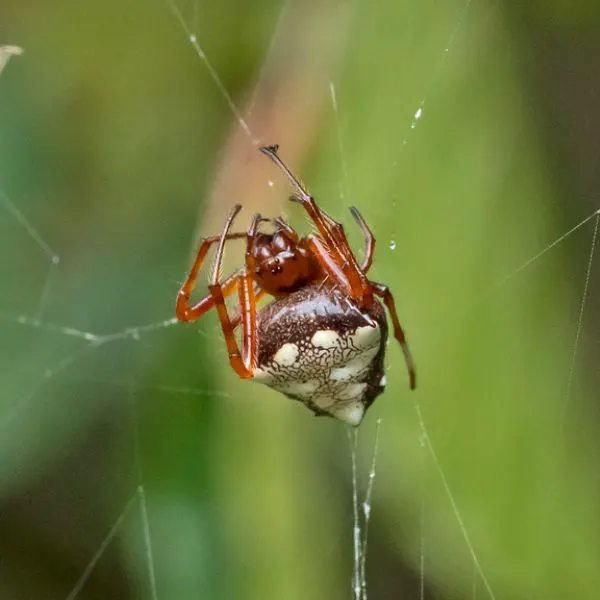
- Experience Level: Beginner
- Family: Araneidae
- Scientific Name: Verrucosa arenata
- Other Names: Arrowhead Spider, Triangulate Orb-weaver
- Adult Size: 0.15 to 0.55 inches
- Lifespan: Up to 1 year
- Average Price Range: N/A
This spider’s abdomen is shaped like a triangle or arrowhead, which is where the spider gets its name. In addition, this arachnid has a yellow triangular or arrowhead-shaped pattern with red spots spread over the back of its abdomen.
Like most orb-weavers, the abdomen is larger than the cephalothorax. The body is tea brown, although the non-yellow parts of the abdomen are more reddish than pure brown.
The arrowhead orb-weaver is carnivorous and spins webs as wide as two feet to catch arthropod prey. It then hangs downwards in the web’s center, waiting for insects to fly into its sticky nest.
You’ll typically find the web of this species in vegetation-rich areas, such as woodlands, forests, and gardens. It favors humid places with good exposure to sunlight.
This critter is venomous, as virtually all spiders are. But its venom is harmless to humans, and bites are uncommon. At most, you’ll experience mild to moderate pain that clears up on its own.
24. Spotted Orbweaver
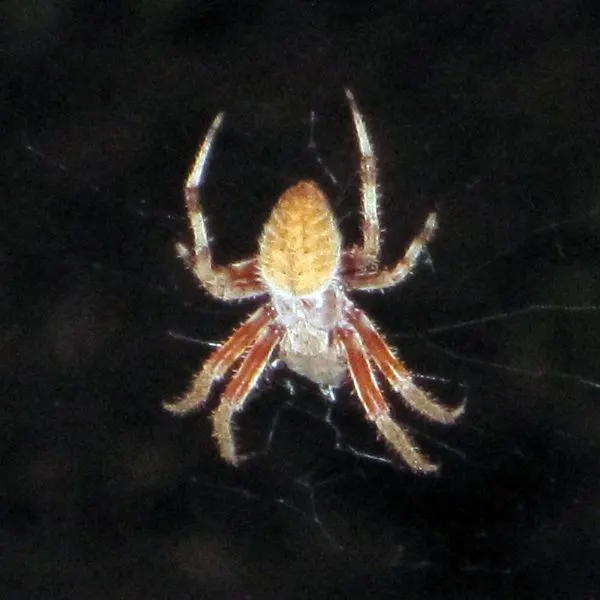
- Experience Level: Beginner
- Family: Araneidae
- Scientific Name: Neoscona crucifera
- Other Names: Barn Spider, Hentz Orb-weaver
- Adult Size: Up to 0.75 inches
- Lifespan: 1 year
- Average Price Range: N/A
The spotted orb-weaver has a large, oblong abdomen covered in sharp bristles.
It is brown, and the abdomen has spots in the middle and dark markings on the sides of the back. In adults, the pattern on the abdomen is indistinct.
Like the abdomen, the carapace and lower half of the legs are also covered in tiny bristles. The whitish bristles form an alternating ban pattern with the brown skin on the legs.
This orb-weaver is a web-spinning that doesn’t pursue prey before consuming them.
Instead, it spins webs as wide as two feet and waits for prey to get tangled in them before attacking. While its venom kills its victims, it doesn’t cause any severe human symptoms.
Spotted orb-weavers are primarily nocturnal, so you’ll have difficulty finding them during the day. Despite this, some females occasionally hang out in their webs in daylight during the fall seasons.
You’re more likely to find orb-weavers in damp areas with vegetation, such as forests and grassy fields. They favor gardens and parks when in residential areas.
25. Red-femured Spotted Orbweaver
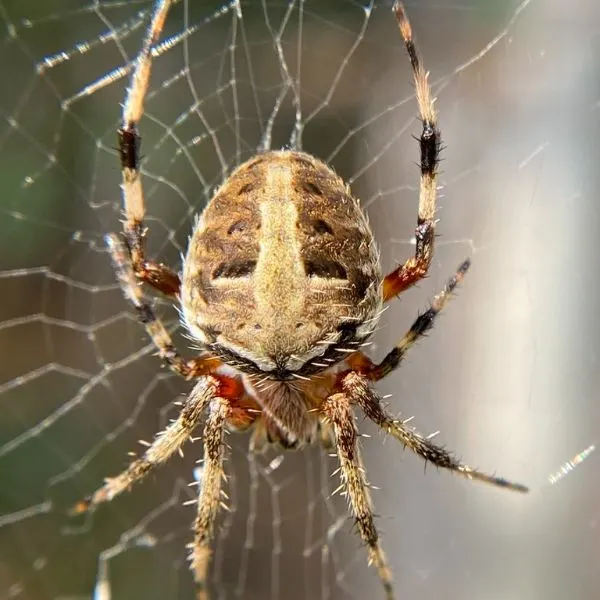
- Experience Level: Beginner
- Family: Araneidae
- Scientific Name: Neoscona domiciliorum
- Other Names: Barn Spider, Hentz Orb-weaver
- Adult Size: 0.3 to 0.63 inches
- Lifespan: 1 year
- Average Price Range: N/A
The red-femured spotted orb-weaver is a close relative of the spotted orb-weaver. Many people often mix the two up because of their similarities, but they aren’t impossible to differentiate.
For starters, red-femured spotted orb-weavers have a more conspicuous pattern on their abdomen. The abdomen is whitish or cream, with broad, dark markings running down on both sides of the back.
The lower legs of this species are banded with light and dark colors. You’ll also notice that the femur (upper half) of each leg is red, which is where the name comes from.
Red-femured orb-weavers are nocturnal spiders that rely on the webs they spin for food. They feed primarily on insects, but they aren’t picky about the kinds of arthropods they eat.
You’ll find them in gardens, prairies, parks, and forests. They favor damp places and tend to flee when disturbed.
Red-femured orb-weavers only bite when they feel threatened and can’t escape. If one bites, you might feel pain and mild discomfort in the bite area. Luckily, the venom doesn’t cause serious symptoms.
26. Tan Jumping Spider

- Experience Level: Beginner
- Family: Salticidae
- Scientific Name: Platycryptus undatus
- Other Names: Jumping Spider
- Adult Size: 0.33 to 0.51 inches
- Lifespan: 1 year
- Average Price Range: N/A
The tan jumping spider is mostly black and tan with whitish hairs all over its body.
The back of the abdomen has whitish markings that run down the center. While its body is shaped like a bold jumper, it lacks the red spots and green fangs characteristic of its cousin.
You’re most likely to encounter this spider outdoors on tree barks, building walls, and wooden surfaces. It sometimes moves indoors to escape unfriendly seasonal conditions, but indoor sightings are relatively uncommon.
Like other jumping spiders, this species is a hunter. It has eight eyes and excellent vision, which it uses to locate prey. It then pounces on its victim and injects it with venom before consuming it.
Tan jumping spiders make great pets. Besides being good-looking, they scarcely bite. Feel free to pick this spider up and watch it hop around on your skin.
Unless pressed too tightly, jumping spiders won’t bite. Even when they do, the effect is negligible because their venom is weak against humans.
27. Magnolia Green Jumping Spider

- Experience Level: Beginner
- Family: Salticidae
- Scientific Name: Lyssomanes viridis
- Other Names: Magnolia Green Jumper
- Adult Size: 0.2 to 0.3 inches
- Lifespan: 1 year
- Average Price Range: N/A
Magnolia green jumping spiders are pretty critters with pale or translucent green bodies.
Their abdomens and legs are covered in small hairs, while their faces have an orange and white patch around the eyes. The most prominent pair of eyes are greenish, not black like the rest.
Their legs are longer and slimmer than those of most jumping spiders. While these features help them jump higher than their closest jumping spider relatives, their best jumps are still modest when compared with species like the bold jumper.
You’ll often find magnolia green jumping spiders in areas abundant with green vegetation. They spend plenty of time on leaves in forests or gardens and ambush arthropod prey they find along their paths.
Although they don’t spin silk webs, they spin silk draglines to assist them when performing daring jumps. They also spin sacs to protect their eggs, which they guard until spiderlings emerge.
Magnolia green jumping spiders are safe to play with. They rarely bite unless handled roughly. Fortunately, the venom of this species is harmless to humans.
28. Arabesque Orbweaver
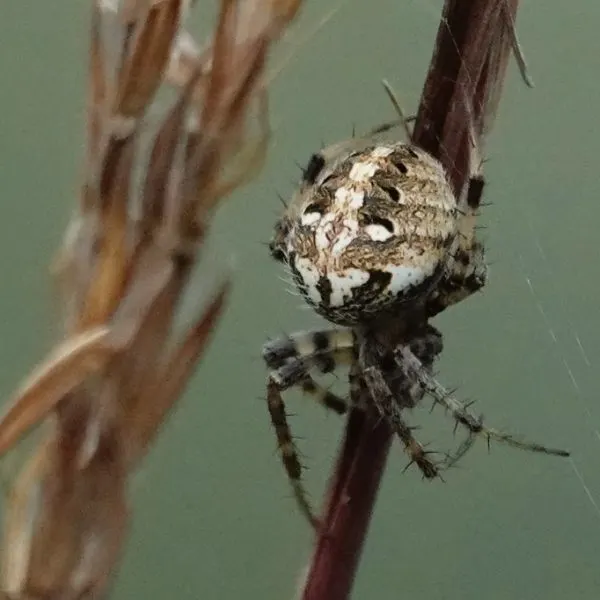
- Experience Level: Beginner
- Family: Araneidae
- Scientific Name: Neoscona arabesca
- Other Names: Orbweaver
- Adult Size: 0.20 to 0.28 inches
- Lifespan: 1 Year
- Average Price Range: N/A
The arabesque orb-weaver is a close relative of the spotted orb-weaver.
Like the spotted orb-weaver, this species has a large abdomen covered in bristles. The back of the abdomen also has an intricate arabesque pattern similar to those in designs from Moorish times.
In adults, the arabesque pattern is less distinct and partially obscured by the bristles on the spider’s back.
But you can still identify it by the dark slanting lines on its abdomen. The coloration of this arachnid varies among individuals, with tan, rusty brown, orange, and yellowish variants.
The legs are spiny and help in building its large, wheel-shaped webs. These webs are used to catch prey, which the spider injects with venom before liquefying. Since this spider is nocturnal, you’ll usually only find it on its webs at night.
In the daytime, females usually hide in rolled-up leaves. Females live longer than males and are noticeably larger, so they are the ones you’ll typically encounter. They favor forest areas and damp places with good vegetation.
Arabesque orb-weavers don’t bite unless threatened.
When they do, it is typically their last resort. Thankfully, their venom is essentially harmless. But you might experience mild pain and skin irritations if you’re allergic.
29. Dark Fishing Spider
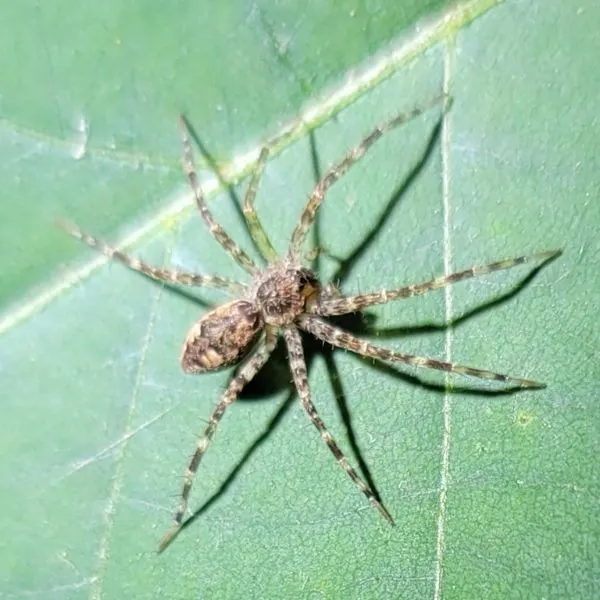
- Experience Level: Beginner
- Family: Pisauridae
- Scientific Name: Dolomedes tenebrosus
- Other Names: Wharf Spider, Dock Spider, Raft Spider
- Adult Size: 0.27 to 1.02 inches
- Lifespan: 1 to 2 years
- Average Price Range: N/A
The dark fishing spider is a mottled black and brown spider with whitish markings on its body. Many people wrongly mistake it for a wolf spider because of its shape and thick, hairy body.
The back of the abdomen has several dark W-shaped markings, while the legs have a blotchy pattern with light and dark bands. You’ll usually find it resting with its legs stretched out.
This species loves to hang out in damp places. You may find it around water sources, but this isn’t always the case.
While sightings are common in forests, woodlands, and gardens, it also sometimes enters residential buildings and hide under debris.
Like all fishing spiders, this species is a skilled hunter. It doesn’t build webs to catch prey. Instead, it tracks them down and pounces on victims to immobilize them with its venom.
The dark fishing spider hunts on the ground and in the water. When hunting on water surfaces, it picks off aquatic insects and often locates prey by detecting vibrations on the water surface.
Besides hunting on the surface, this arachnid also often dives far below the surface to seize and inject prey swimming underneath. Its victims are often other arthropods, but it sometimes attacks and feeds on tiny fishes and tadpoles in the water.
Dark fishing spiders often appear intimidating, mainly because of their size and hairiness. But these spiders are safe to be around. They don’t sting unless provoked, and their venom isn’t medically significant.
30. Spined Micrathena

- Experience Level: Beginner
- Family: Araneidae
- Scientific Name: Micrathena gracilis
- Other Names: Castleback Orb-weaver
- Adult Size: 0.2 to 0.4 inches
- Lifespan: 1 year
- Average Price Range: N/A
The spined micrathena’s abdomen is many times the size of its cephalothorax. It is mostly whitish or cream-colored, and the sides and rear are lined with dark, pointy protrusions or spines.
The cephalothorax and legs are chocolate brown to black. Besides the dark spots on the abdomen and dark markings on its spines, the spined micrathena has no distinct pattern. But it’s hard to mistake for another species.
Male spined micrathenas lack the spiny protrusions on the back of females. These protrusions likely dissuade predators from attacking females, but it’s unclear what purpose they serve.
Spined micrathenas are orb-weavers that spin spiral webs to trap prey instead of hunting them down. They feed on various arthropods, but insects like gnats and flies make up the bulk of their diet.
Like other orb-weavers, this species is not aggressive towards humans. It is venomous, as most spiders are, but its venom doesn’t cause any serious symptoms.
31. Golden Jumping Spider
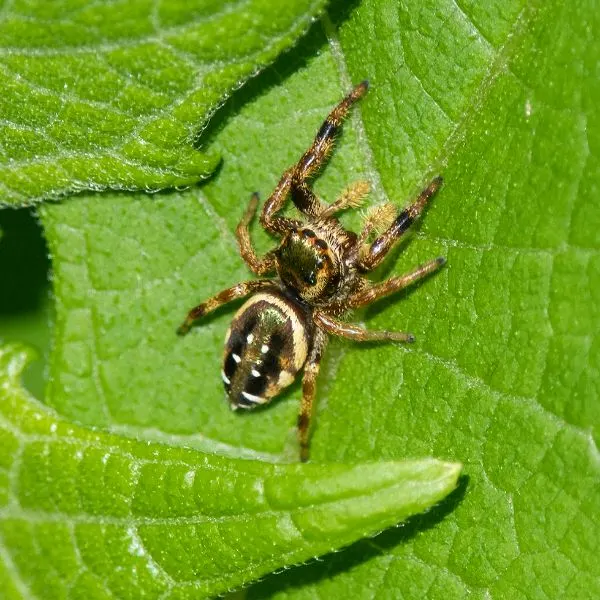
- Experience Level: Beginner
- Family: Salticidae
- Scientific Name: Paraphidippus aurantius
- Other Names: Emerald Jumping Spider
- Adult Size: 0.28 to 0.47 inches
- Lifespan: 1 year
- Average Price Range: N/A
Stunning is the only word that describes the golden jumping spider.
This brown to black spider has a lustrous, emerald green abdomen with a few pairs of dark spots in the middle. In addition, the abdomen is lined on all sides with orange markings.
Like the abdomen, the middle of the carapace is emerald green, but the sides are covered in brownish hair. The legs are also covered in hairy brown and orange hair, but the dark base color is more visible here.
Golden jumping spiders are active and rarely stay in the same place. They can jump to impressive heights and often spin silk draglines to make their jumps easier.
Like other jumping spiders, these arachnids don’t spin webs to snare prey.
Golden jumpers are skilled hunters with excellent eyesight. They ambush prey and inject their victims with venom before consuming them or carting them away.
You’ll usually find these critters outdoors, but they sometimes stray into houses in search of food or warmth from harsh weather. They rarely bite, and their venom is harmless to humans.
32. Arrow-shaped Orbweaver
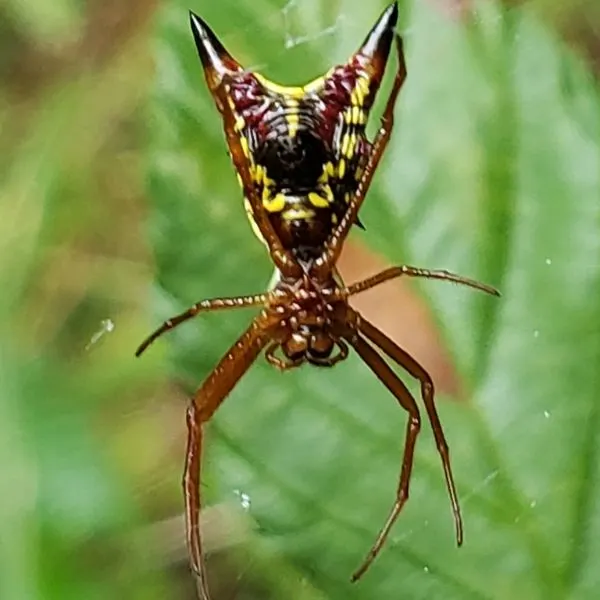
- Experience Level: Beginner
- Family: Araneidae
- Scientific Name: Micrathena sagittata
- Other Names: Arrow-shaped Micrathena
- Adult Size: 0.2 to 0.35 inches
- Lifespan: 1 year
- Average Price Range: N/A
The arrow-shaped orb-weaver is related to the spined micrathena.
It has a brown body and a triangular abdomen shaped like an arrowhead. The carapace has a yellowish stripe on each side, and the back of the abdomen is largely yellow with dark spots.
You can easily identify the female arrow-shaped micrathena by the pair of large, sharp crowns at the rear of its abdomen. These protrusions are reddish with black tips, and they extend outwards on either side to give the spider its arrow-shaped appearance.
Females also have two smaller pairs on the upper sides of their abdomen.
Male arrow-shaped orb-weavers are smaller than females and live much shorter lives. Except during mating seasons, you’ll scarcely see them around.
Like other orb-weaving spiders in Virginia, arrow-shaped orb-weavers are carnivorous and rely on webs to trap prey. They spin large, spiral webs and wait for prey to get entangled.
They aren’t aggressive spiders, so there’s nothing to fear when you see them. Although they sometimes bite when threatened, their venom doesn’t cause any serious symptoms.
33. White-banded Crab Spider
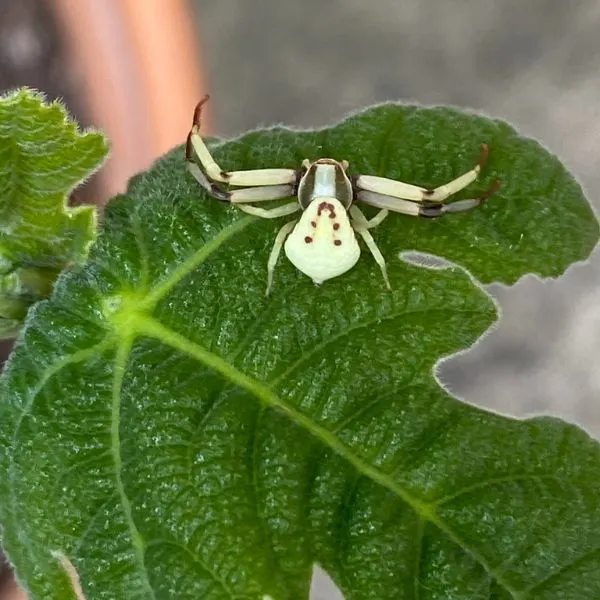
- Experience Level: Beginner
- Family: Thomisidae
- Scientific Name: Misumenoides formosipes
- Other Names: Yellow Crab Spider, Crab Spider, White Crab Spider, Ridge-faced Flower Spider, Red-banded spider
- Adult Size: 0.31-0.55 inches
- Lifespan: 1 year
- Average Price Range: N/A
The white-banded crab spider is a yellowish-brown to whitish-yellow. It gets its name from the white band running between its eyes and the back of its abdomen. You’ll usually find it perched on flowerheads.
The white-banded crab spider has the unique ability to change its colors to match its surroundings. This fascinating arachnid can only switch between white and green, depending on the color of the flower it’s perched on.
Although this color change can take a few days, its cryptic coloration provides it with effective camouflage from predators and prey. The white-banded crab spider is a hunter that feeds mostly on insects that come to pollinate the flowers it inhabits.
This arachnid is an ambush hunter that doesn’t rely on webs to catch prey. Like all crab spiders, it has big and strong front limbs. It uses them to grab unsuspecting pollinators before injecting them with venom.
The venom of the white-banded crab spider is not medically significant. Bites can be painful, but you won’t experience any serious symptoms.
34. Rabid Wolf Spider

- Experience Level: Beginner
- Family: Lycosidae
- Scientific Name: Rabidosa rabida
- Other Names: Wolf Spider
- Adult Size: 0.43 to 0.83 inches
- Lifespan: Up to 2 years
- Average Price Range: N/A
Rabid wolf spiders are tan spiders with one broad, dark stripe running down the back of their abdomens.
The middle of their cephalothorax is tan with two dark stripes on either side. In addition, you’ll notice tan eyebrow-like curves above its topmost pair of eyes.
These arachnids have sparsely spined tan legs with brown stripes. At first sight, you might mistake them for fishing spiders.
Rabid wolf spiders aren’t rabid in the way rabid dogs are.
They aren’t aggressive towards people, but they can seem pretty crazy. These enthusiastic spiders often move haphazardly when chasing prey or going about their day.
As skilled hunters, these arthropods do not spin webs to catch prey. But they spin silk for other purposes.
For example, female rabid spiders often spin silk egg sacs that they carry around on their spinnerets until their eggs hatch.
When spiderlings emerge, female rabid wolf spiders care for them. A female rabid wolf spider typically carries her babies on her back for a while.
These young spiders feed on the yolk sac on their mother’s back before moving on to start their lives.
Although the name of this spider sounds intimidating, the rabid wolf spider shouldn’t inspire fear. It only bites when threatened, but its venom is not medically significant.
35. American Green Crab Spider

- Experience Level: Beginner
- Family: Thomisidae
- Scientific Name: Misumessus oblongus
- Other Names: Foliage Flower Crab Spider, Ridge-Faced Flower Spider
- Adult Size: 0.12 to 0.5 inches
- Lifespan: 1 Year
- Average Price Range: N/A
The American green crab spider is a greenish spider covered in tiny spines.
The abdomen is brownish, and the legs have dark brown bands. Some also have reddish markings on their sides. Like the white-banded crab spider, this species usually stays in flowerheads.
This arachnid’s green color allows it to blend easily in flowers, where it waits for pollinators. It has strong front legs, which it uses to grab prey before immobilizing them with venom.
The legs of American green crab spiders allow them to move easily in any direction without turning. They can move forward, backward, and sideways more efficiently than other spiders in Virginia.
You’ll usually encounter American green crab spiders in forests, grasslands, and gardens. Like many spiders in Virginia, they also sometimes wander indoors. Sightings are most common in May.
Although they don’t spin webs to catch prey, female American green crab spiders spin silk cocoons to house their eggs. They are protective of their egg sacs, but they often die shortly after their eggs hatch.
The American green crab spiders are non-aggressive towards people, and the venom they inject is harmless to humans.
36. White-jawed Jumping Spider
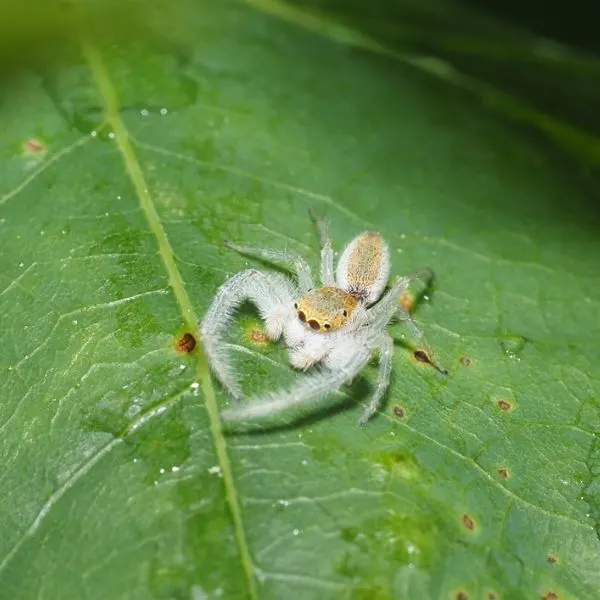
- Experience Level: Beginner
- Family: Salticidae
- Scientific Name: Hentzia mitrata
- Other Names: Crowned Hentzian Jumping Spider, Jumping Spider
- Adult Size: 0.16 to 0.17 inches
- Lifespan: 1 year
- Average Price Range: N/A
White-jawed jumping spiders come in many forms, but their bodies are typically covered in white bristly hairs.
The center of their abdomens and carapaces are golden brown to coppery brown. Their first pair of legs is also larger than the rest.
These arachnids don’t build web traps. They are hunters that revel in pursuing prey, which they then paralyze with venom before consuming them.
Although they don’t build webs, they spin silk draglines to support their jumps.
Female white-jawed jumping spiders also spin silk cocoons around their eggs to protect them. These spiders guard their egg sacs for a few weeks until they hatch.
Sadly, most die shortly after their young move out on their own.
You’ll typically find white-jawed jumping spiders outdoors in forests and other vegetation-rich areas. They also sometimes stray indoors in search of food.
Feel free to play with jumping spiders, but be careful while handling them. They bite when threatened. But while this bite can be painful, the venom they inject is harmless to humans.
37. Bronze Jumping Spider
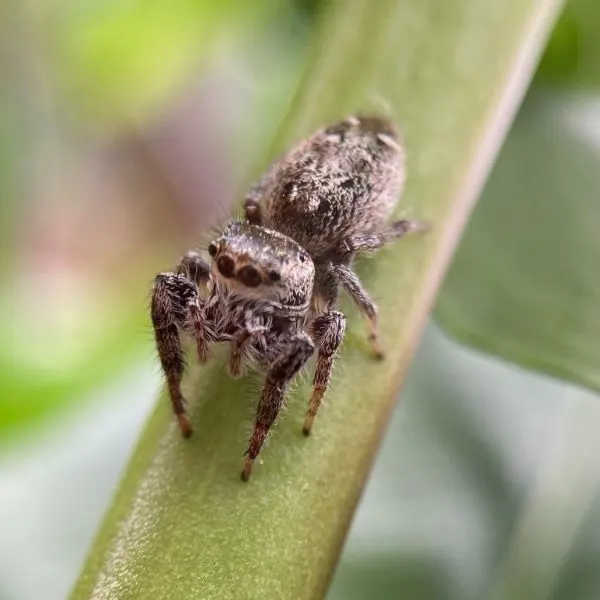
- Experience Level: Beginner
- Family: Salticidae
- Scientific Name: Eris militaris
- Other Names: Bronze Lake Jumping Spider, Bronze Jumper, Bronze Lake Jumper
- Adult Size: 0.19 to 0.35 inches
- Lifespan: 1 year
- Average Price Range: N/A
The bronze jumping spider is a bronze-brown spider with whitish markings on the sides of its face and abdomen. The legs are a mix of bronze, brown, and black.
Like all jumping spiders, it has an enlarged pair of eyes in front of its head.
Female bronze jumping spiders lack the white side marking present in males. In addition, females have a darker abdomen than cephalothorax, while the reverse is the case with males.
You’ll find bronze jumping spiders in Virginia’s forests and gardens. These fine spiders are active, often leaping on plants and walls in search of food.
Unlike most spiders in Virginia, these arachnids are hunters that don’t spin web snares for prey.
They only spin silk draglines to assist them while making dangerous jumps. Besides these draglines, bronze jumping spiders also spin cocoons to house their eggs. Females guard these eggs until they hatch but die shortly after.
Bronze jumping spiders are friendly, but they will bite when threatened. Fortunately, the venom this spider injects doesn’t cause any serious reactions.
38. Basilica Orbweaver
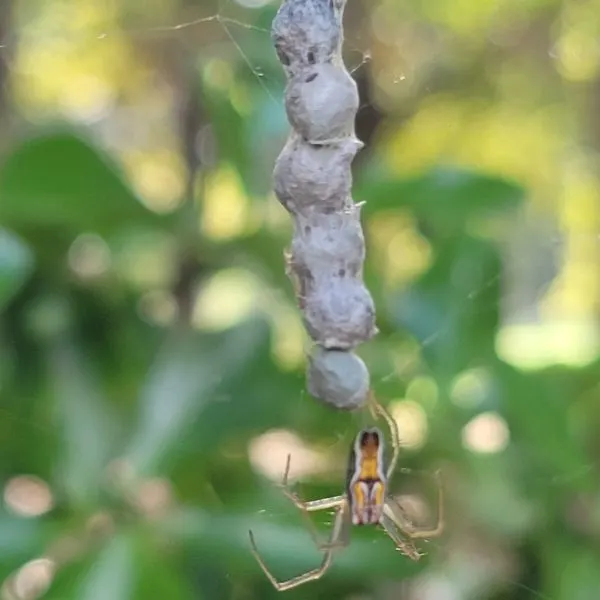
- Experience Level: Beginner
- Family: Araneidae
- Scientific Name: Mecynogea lemniscata
- Other Names: Basilica Orbweaver
- Adult Size: 0.19 to 0.35 inches
- Lifespan: 1 year
- Average Price Range: N/A
Basilica orb-weavers are colorful spiders with an orange cephalothorax with black markings on the sides. The abdomen of this species has several irregular stripes of white, green, orange, black, and yellow.
Like most orb-weavers, the basilica orb-weaver’s abdomen is several times larger than its cephalothorax. But the difference isn’t as stark as in other orb-weavers like the spined micrathena or marbled orb-weaver.
This arachnid spins orb-shaped webs to trap flying insects and other small arthropods. You’ll generally come across its webs suspended between branches or tall grass blades in forests and gardens.
Like most spiders in Virginia, female basilica orb-weavers are larger than males.
Neither sex is aggressive towards people, and they often flee when people approach them. If threatened without escape, females will sting in self-defense.
Fortunately, the venom of this spider is harmless to humans. It doesn’t hurt more than a bee sting.
39. Ribbon Jumping Spider
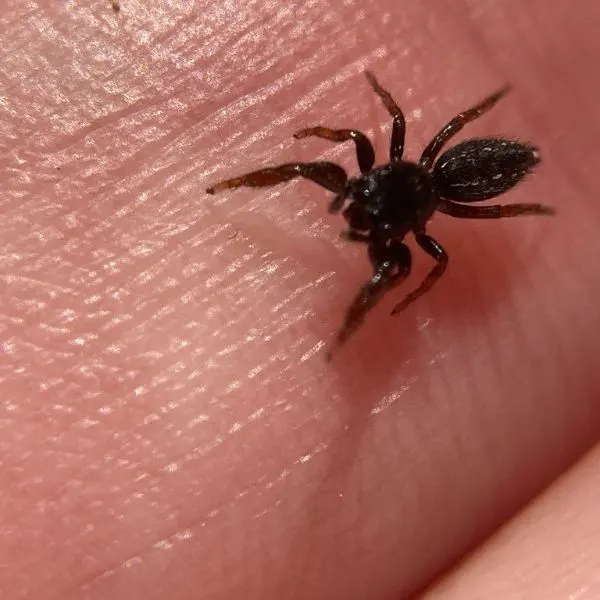
- Experience Level: Beginner
- Family: Salticidae
- Scientific Name:
- Other Names: Ribbon Jumper
- Adult Size: 0.17 to 0.28 inches
- Lifespan: 1 year
- Average Price Range: N/A
Ribbon jumping spiders are black with two light brown stripes running down their abdomens. The cephalothorax also has light stripes on the sides and the legs are dark brown.
Like other jumping spiders, this species is active and can jump a few times its body length. It doesn’t build web traps.
Instead, this skilled hunter prefers tracking its prey before pouncing on them.
While it doesn’t spin web traps, the ribbon jumper spins silk safety lines to use while jumping. Females also make silk egg sacs, which they guard until the eggs hatch.
Unfortunately, they die shortly after their spiderlings emerge.
Jumping spiders only bite when threatened, but they are safe to be around. There’s no risk of serious injury because their venoms have negligible effects.
40. Rabbit Hutch Spider
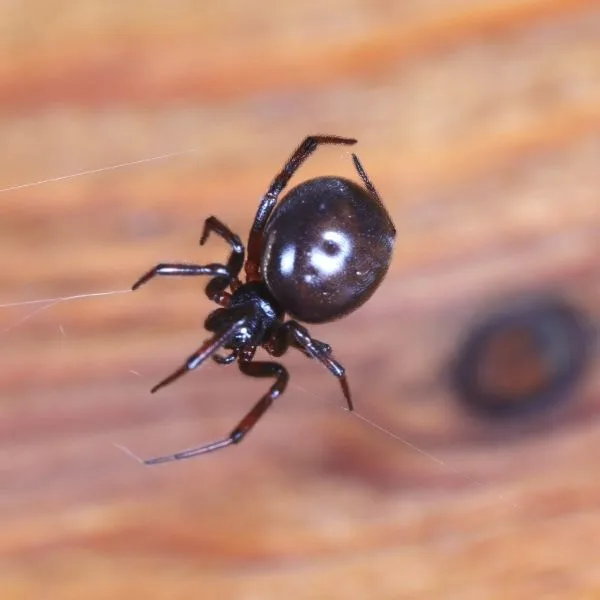
- Experience Level: Beginner
- Family: Theridiidae
- Scientific Name: Steatoda bipunctata
- Other Names: False Black Widow
- Adult Size: 0.31 inches
- Lifespan: 1 to 6 years
- Average Price Range: N/A
The rabbit hutch spider is another black widow relative that people often mistake for true black widows.
But, unlike black widows, this species doesn’t have a red hourglass marking. It is a dark brown to black spider with banded legs and a bulbous abdomen.
The abdomen of the rabbit hutch spider has a light line that curves around it anteriorly. This line runs down the abdomen in the middle but tapers off halfway. Besides this line, this arachnid has no distinct pattern.
Rabbit hutch spiders spin messy webs and prey on other arthropods, including true black widows. Fortunately, their venom is pretty harmless compared to widows. It doesn’t cause any serious symptoms and incidences are rare.
41. Canopy Jumping Spider
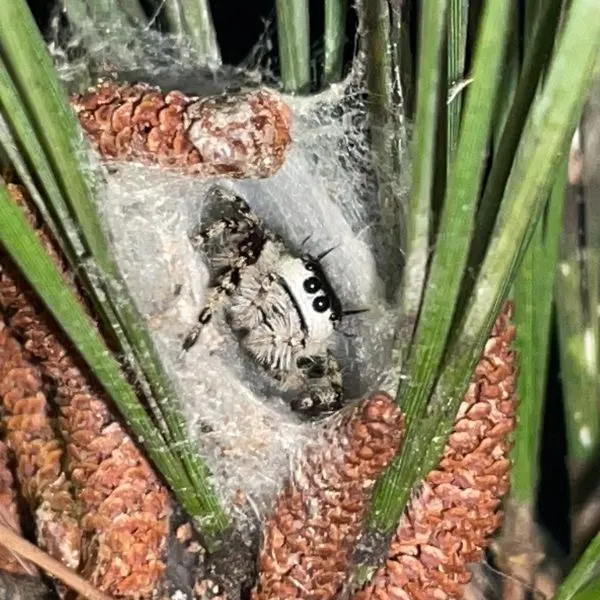
- Experience Level: Beginner
- Family: Salticidae
- Scientific Name: Phidippus otiosus
- Other Names: Canopy Jumper
- Adult Size: Up to 0.63 inches
- Lifespan: 1 year
- Average Price Range: N/A
The canopy jumping spider is a dark brown spider covered in orange-brown hairs.
The fangs are reddish, the face has a white band, and the brown abdomen has a few orange markings. Like its bold jumper sibling, this species has noticeably short legs.
Canopy jumping spiders can perform impressive jumps. As hunters, these arachnids don’t spin webs to catch prey. But they spin silk safety lines that help cushion the impact of failed jumps.
Female canopy jumpers are also protective of their young. They spin silk egg sacs, which they guard until the eggs hatch. Afterward, they stay with their spiderlings for a while before dying.
Canopy jumping spiders can be friendly, but they might bite if you mishandle them. Fortunately, their venom is harmless. Serious bites don’t hurt more than a bee sting, and people generally feel nothing.
42. White-banded Fishing Spider

- Experience Level: Beginner
- Family: Pisauridae
- Scientific Name: Dolomedes albineus
- Other Names: Fishing Spider
- Adult Size: 0.7 to 0.9 inches
- Lifespan: 1 to 2 years
- Average Price Range: N/A
You won’t always find white-banded fishing spiders near rivers or water sources.
However, they favor damp places. You may encounter these arachnids in coastal forests and gardens, but they sometimes stray into man-made structures.
White-banded fishing spiders range from brown to light yellowish-green. They have a white band just under their eyes and around the mouthparts.
In addition, their legs have light and dark rings, while their carapaces are sometimes entirely white with a central black spot.
Like other fishing spiders, this species is a hunter. It tracks arthropod prey on land, but it can also walk on water without sinking. It consumes aquatic insects hanging to the water film but sometimes dives in to catch other prey.
White-banded fishing spiders don’t build silk webs, but they spin silk sacs for their eggs. Mothers guard these sacs until their eggs hatch.
After hatching, most female white-banded fishing spiders remain protective of their spiderlings for a while.
These spiders aren’t as venomous as black widows and are typically unaggressive. Although their bites don’t cause serious symptoms, forceful bites can be painful.
This is usually the last resort of individuals unable to escape your tight grip.
43. Black-tailed Red Sheetweaver
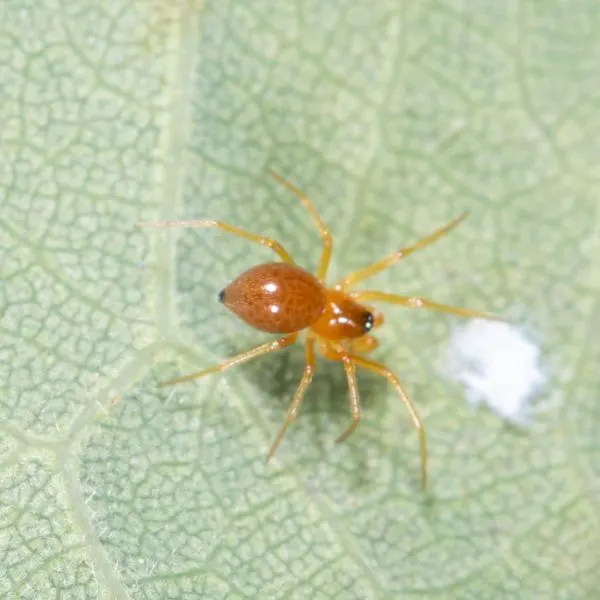
- Experience Level: Beginner
- Family: Linyphiidae
- Scientific Name: Florinda coccinea
- Other Names: Red Grass Spider
- Adult Size: 0.12 to 0.16 inches
- Lifespan: 1 year
- Average Price Range: N/A
The black-tailed red sheetweaver’s name is pretty descriptive.
This fascinating arachnid has a red body, and the tip of its abdomen is black. Unlike the body, the legs are green and spiny.
You’ll usually come by these spiders in prairies and grassy fields. In urban areas, black-tailed red sheetweavers are partial to lawns, fields, and parks with grassy vegetation.
Black-tailed red sheetweavers aren’t hunters. As is typical of sheet-weavers, they spin flat, non-sticky webs to catch their prey.
This species often spins one vertical one and another horizontal one underneath.
Also called red grass spiders, females are larger than males. Female abdomens are more bulbous and noticeably wider than males. They also have longer lifespans and are the ones you’ll usually encounter.
These tiny spiders scarcely bite people. Even when provoked into doing so, their venom is harmless to humans.
44. Spitting Spider
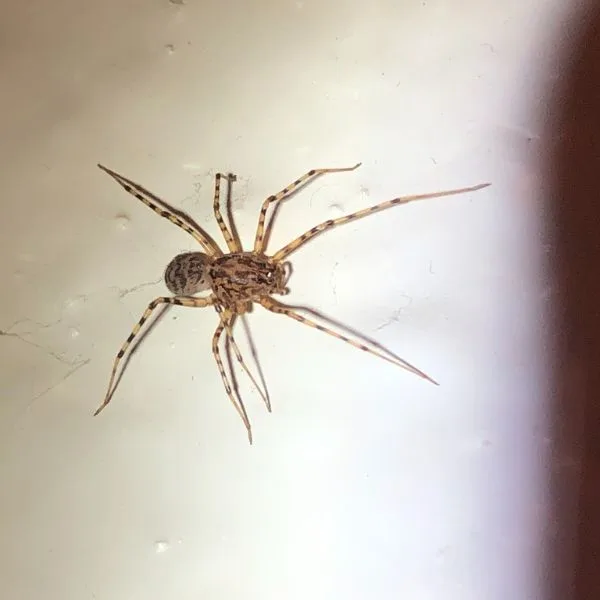
- Experience Level: Beginner
- Family: Scytodidae
- Scientific Name: Scytodes thoracica
- Other Names: Spitting Spider
- Adult Size: 0.15 to 0.25 inches
- Lifespan: 1.5 to 2 years
- Average Price Range: N/A
Spitting spiders are built differently from most spiders in Virginia.
They have yellowish-brown or light brown bodies covered in solid brown markings. In addition, their round abdomens are roughly the same size and shape as their cephalothorax.
Unlike most spiders in Virginia, these arachnids have six eyes instead of eight. But their most peculiar feature is their ability to shoot venomous silk strands from their heads.
Spitting spiders can do so because they have two extra silk glands on their heads.
As hunter spiders, this ability helps them immobilize prey without pouncing on it. They shoot their venomous silk from a distance and don’t stop until their victim stops moving.
Afterward, they consume their prey or wrap it in silk for later consumption.
The venomous silk these spiders eject is only effective against small prey. Fortunately, the venom is entirely harmless to people.
45. Garden Ghost Spider

- Experience Level: Beginner
- Family: Anyphaenidae
- Scientific Name: Hibana gracilis
- Other Names:
- Adult Size: Up to 0.5 inches
- Lifespan: 1 Year
- Average Price Range: N/A
Garden ghost spiders are skilled predators with scissor-like jaws that can move from side to side. They have eight eyes like most spiders, but these eyes are huddled close together and resemble a smiley.
They have broad but elongated abdomens. Most have brown and yellow or greenish bodies with dark markings and spiny legs.
If you encounter variants without dark markings, you might mistake them for yellow sac spiders.
People call these arachnids ghost spiders because they are active at night and have pale bodies that are easy to miss. Although they don’t build webs to trap prey, they spin silk webs in shaded spots to retreat into.
You’ll usually find these spiders in forests and gardens, where they feed on arthropods. Although arthropods are their primary food source, they may also consume flower nectar and pollen to derive energy for their activities.
Male garden ghost spiders court females by vibrating their abdomens during courtship seasons. Like many spiders in Virginia, females spin egg sacs and are protective of them until spiderlings emerge.
Garden ghost spiders are venomous, but their venom isn’t medically significant. You’ll usually only experience mild to moderate pain and swelling that may take some time to subside. But it has no lasting impact.
Frequently Asked Questions
Still have questions about spiders in Virginia? Find the answers to your most pressing questions here.
What do spiders in Virginia eat?
Spiders in Virginia and elsewhere consume mainly arthropods. Many species are also cannibalistic, consuming spiders of other or their own species.
Some species also feed on non-arthropod prey, such as fishes and slugs. This kind of diet is more common among generalist feeders like fishing spiders.
Do spiders in Virginia have good eyesight?
Some spiders in Virginia have excellent vision. Although most spiders in Virginia have eight eyes, only a handful of these are for seeing. The rest mainly serve as motion detectors, which help them quickly locate prey and evade predators.
Species with poor eyesight rely primarily on their ability to detect vibrations in their surroundings. For example, many web-spinning spiders have highly developed vibratory senses.
Where can I find spiders in Virginia?
You can find spiders almost anywhere in Virginia. If you’re not particular about the species, your home is the first place to look. You’ll likely find one or two spiders in your ceiling corners, crevices on your door, your attic, or on your front porch.
If you’re interested in diversity, forests and areas with ample vegetation are the best places to check. You’ll typically find them resting on webs between trees or hiding away under rocks and forest debris.
Are there any poisonous spiders in Virginia?
Virtually all the spiders in Virginia are venomous, meaning they inject a toxin when they bite. This is different from being poisonous.
Fortunately, the venom in most spiders in Virginia is harmless to humans. Some don’t cause any symptoms, while others only trigger mild pain and swelling.
Brown recluses and black widows are the only dangerous species in Virginia. These arachnids inflict medically significant bites that usually require medical attention.
Can a spider bite kill you?
Yes. But fortunately, this is an extremely rare outcome.
Some spiders inject venom toxic enough to cause adverse symptoms that result in death. Black widows are a prime example of such spiders.
If left untreated, bites from these spiders can kill people with weak immune systems. Therefore, you should always seek medical attention if a medically significant species bites you.
What is the deadliest spider in Virginia?
The northern and southern black widows are the deadliest spiders in Virginia. Although bites rarely kill people, it is a possible outcome in immunocompromised persons, children, and older adults.
Even bites that don’t result in death can be debilitating. The neurotoxin these spiders inject causes latrodectism. Symptoms include fever, pain, sweating, vomiting, difficulty breathing, and muscle stiffness.
Are there brown recluses in Virginia?
Yes. There are brown recluses in Virginia. However, these spiders are not often sighted in the state. Brown recluses aren’t native to Virginia, so their populations are small.
Sightings are usually isolated incidents, possibly of recluses that have hitchhiked into the state through vehicles or luggage.
Are there jumping spiders in Virginia?
Yes. There are jumping spiders in Virginia. The state has several jumping spider species, from bold jumpers to tan jumping spiders.
Are there tarantulas in Virginia?
Virginia has large spiders that some people mistake for tarantulas, such as some wolf spiders and fishing spiders. But there are no confirmed sightings or established populations of any tarantula species in the state.
Are Virginia tarantulas poisonous?
Tarantulas are venomous spiders, but they aren’t medically significant. So for now, it’s safe to say there aren’t any venomous or poisonous tarantulas in Virginia.
Is it legal to own a pet spider in Virginia?
Yes. It is legal to own pet spiders in Virginia. Most spiders have secure populations because of their resilience and high reproductive rates. As long as you take care of your pet spiders, you aren’t harming the ecosystem by keeping some as pets.
Many spiders in Virginia make great pets. You can even keep venomous species like black widows as pets as long as you take precautions to protect yourself from their bites.
How many species of spiders are there in Virginia?
Virginia is home to over 60 spider species. However, many of these species are uncommon or rarely sighted. The specific number of species is unknown because many remain unidentified.
What are the most common spiders in Virginia?
Orb-weavers and jumping spiders are among the most common spiders in Virginia. The state is home to numerous orb-weaving and jumping spiders, each one unique in its own way.
Wrapping up
The spiders in Virginia are nearly as diverse as they are numerous. While these fascinating arthropods have had a bad rep for years, you’ll find many species worth keeping around in the state.
While some species have different habitat preferences, many house spiders in Virginia prefer staying in damp, undisturbed places like wall and ceiling corners, garages, or cellars. Always check these places to know which species live in your home.
If you find highly venomous spiders in your home, the ideal thing to do is remove them. You can leave harmless species alone after cleaning your space. Sometimes these spiders are the vanguard keeping more sinister critters out of your house.
More spiders in nearby states
